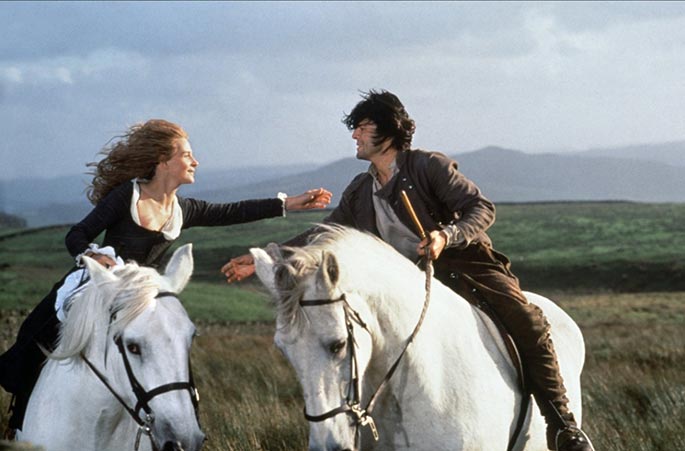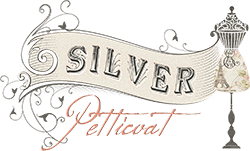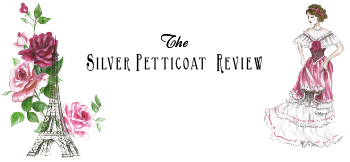Photo: Paramount Pictures
Wuthering Heights Versus Beauty and the Beast
The wind is certainly “wuthering” in Yorkshire at the moment, thanks to storms Abigail and Barney. So what better time for my Fairy Tales in Classics mini-series to turn to Wuthering Heights? Written by Emily Bronte in 1847, it has remained a firm favourite ever since, with numerous film and TV adaptations, not to mention the song by Kate Bush!
The fairy tale most people think of in connection with Wuthering Heights is Beauty and the Beast. After all, Heathcliff is beastly and Cathy is beautiful. But does this really work?
Wuthering Heights is a complex, multi-layered novel, with many beginnings and different points of view. However, if we look at the chronological beginning of the tale Nelly Dean tells Mr Lockwood about the history of the Heights, we see an opening that very closely resembles that of Beauty and the Beast. Old Mr Earnshaw is about to set off on a trip to Liverpool, and tells his children, “what shall I bring you? You may choose what you like: only let it be little, for I shall walk there and back.” Hindley asks for a fiddle, Cathy a whip for horse-riding, and Nelly herself is promised a humble gift of apples and pears. Like the merchant in the tale, he returns late and haggard. The promised gifts are lost or broken, and in their place is a “dirty, ragged, black-haired child,” speaking “some gibberish, that nobody could understand.” Mr Earnshaw has not sold his daughter to the beast; he has brought the beast into his home.
RELATED Fairy Tales in Classics – Pride and Prejudice
As I discussed in my article on Pride and Prejudice, much of the meaning of the original Beauty and the Beast concerns the realities of the marriage market and the bride’s fear of her husband’s sexuality and violence. This is absolutely not the case where the elder Cathy Earnshaw is concerned. She is every bit as violent and sexual as Heathcliff is. Only consider her fits of rage – gnashing her teeth and biting her lips until they bleed – and the violent embrace of Cathy and Heathcliff on her last night on earth, “from which,” Nelly Dean says, “I thought my mistress would never be released alive.” Cathy, as she says is Heathcliff. They are masculine and feminine versions of each other.
So what about Isabella Linton? She is abducted to the Heights, to be the wife of “the beast,” Heathcliff. She certainly fears him, and suffers his violence, but only after she is married to him. Before that, she foolishly believes that he is a good man who can be tamed. Actually, he only wants her as revenge on Edgar Linton. Isabella’s story is almost like the classic Beauty and the Beast in reverse!
It turns out that Wuthering Heights is a house full of beasts. There is Hindley Earnshaw, the festering alcoholic, waiting to kill Heathcliff with a shotgun. There is Linton Heathcliff, a monster created from the union of two hostile opposites. And then there is Hareton Earnshaw, the disinherited son.
I believe it is in Hareton and the young Catherine that we see the classic story of Beauty and the Beast most faithfully played out. Hareton is very much the ensorcelled prince of the tale. He ought to be heir to the Heights and a young gentleman. But Heathcliff has remade Hareton in his own image: rough, swearing and illiterate, scorning everything soft and refined. He has become a beast.

Photo: Paramount
Young Catherine comes to the Heights, enticed by her infatuation with Linton Heathcliff, and remains after the boy’s death as Heathcliff’s prisoner. But this is a saga of generations, in which the children can undo the sins of the parents and make everything whole again. Heathcliff’s spell begins to weaken, as he is drawn increasingly towards the ghost of the elder Cathy. Under the influence of the younger Catherine, Hareton is gradually tamed, learning to read and sweetening in temper. In the end, the young people’s land and fortune are restored. Even the old house is released from its Gothic past, with flowers newly planted outside and songs being sung within. It is this young couple – Young Catherine and Hareton – who enjoy the true fairy-tale ending.
Do you see traces of “Beauty and the Beast” in Wuthering Heights? Sound off below…
All quotations are from Emily Bronte, Wuthering Heights (Ware: Wordsworth Editions, 1992).
ARE YOU A ROMANCE FAN? FOLLOW THE SILVER PETTICOAT REVIEW:
 Our romance-themed entertainment site is on a mission to help you find the best period dramas, romance movies, TV shows, and books. Other topics include Jane Austen, Classic Hollywood, TV Couples, Fairy Tales, Romantic Living, Romanticism, and more. We’re damsels not in distress fighting for the all-new optimistic Romantic Revolution. Join us and subscribe. For more information, see our About, Old-Fashioned Romance 101, Modern Romanticism 101, and Romantic Living 101.
Our romance-themed entertainment site is on a mission to help you find the best period dramas, romance movies, TV shows, and books. Other topics include Jane Austen, Classic Hollywood, TV Couples, Fairy Tales, Romantic Living, Romanticism, and more. We’re damsels not in distress fighting for the all-new optimistic Romantic Revolution. Join us and subscribe. For more information, see our About, Old-Fashioned Romance 101, Modern Romanticism 101, and Romantic Living 101.

Wuthering Heights echos the darkness and mystique of Beauty and The Beast. Much like the beast, Heathcliff was imprisoned by his own cruelty. Yet Heathcliff has no redeeming qualities, even his love for Catherine bounds obsessiveness and possessiveness. While the Beast actually sets Beauty free, an honorable act.
The Beast’ narcissism and cruelty turned the castle and all its inhabitants as a prisoner. Heathcliff and Catherine were both prisoners and warden. I can even say Wuthering Heights was their prisoner as well. This is more clear when Catherine Linton and Hareton turned the place into something welcoming rather than a place void of affection. Thus allowing Wuthering Heights to breath again from the memories of Catherine that suffocated the place.
The love of the Beast for Beauty set everyone free while the love of Heathcliff and Catherine made everyone hostages. I agree that Catherine and Hareton are the closest in comparison to Beauty and the Beast that gave a hopeful ending.
Though Heathcliff is united with Catherine in death questioning if the tragic hero was actually punished and if it is a happily ever after ending. Nonetheless, he undoubtedly endured the living tragedy of years tormented by the loss of the woman he lived for.
I always felt there’s this schizophrenic type of love between Catherine and Heathcliff. You can’t deny the existence but their love has a very jarring and perturbing effect to each other that disrupts their sanity.
On a side note, I always hoped Rufus Sewell would have played Heathcliff. I’ve been a fan of his since that sci-fi movie Dark City.
Thanks and always enjoy your articles.
I’m glad someone else has thought about this deeply too. And that you enjoy my articles!